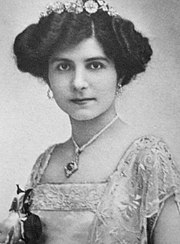Elena of Serbia

Princess Elena Karađorđević of Serbia (born November 4, 1884 in Cetinje , Montenegro , † October 16, 1962 in Nice ) was by marriage Grand Duchess Jelena Petrovna and one of the women who introduced the traveling preacher Rasputin to the Russian Tsarina Alexandra Feodorovna .
Life
Elena was the daughter of King Peter I of Yugoslavia (1844–1921) and Princess Zorka Petrović-Njegoš of Montenegro (1864–1890), the eldest daughter of King Nikola I. Petrović-Njegoš of Montenegro and Milena Vukotić, and sister of the Crown Prince Georg (1887–1972) and the later King Alexander I. Due to the early death of their mother, she was raised largely under the care of her aunts Grand Duchess Anastasia and Grand Duchess Militza , as well as in the Smolny Institute in St. Petersburg . She was a close friend of the Grand Duchess Olga Nikolaevna , the eldest daughter of the Czar. During a visit to Italy with her aunt Queen Elena of Italy and her husband, King Viktor Emanuel III. , she got to know and love the Grand Duke Ivan Konstantinovich. Elena studied medicine at the University of Saint Petersburg until she gave birth to her first child (1914).
On August 21, 1911 Princess Elena Karađorđević of Serbia married Grand Duke Ivan Konstantinowitsch Romanow (1886-1918), the eldest son of Grand Duke Konstantin Konstantinowitsch Romanow and his wife Princess Elisabeth von Sachsen-Altenburg ( Elisabeth Moritzowna ) in Saint Petersburg . The marriage resulted in two children, Vsevolod Ivanovich (1914-1973) and Ekaterina Ivanovna (1915-2007).
In February 1917, a provisional government was formed under Prince Lvov . Shortly afterwards, Tsar Nicholas II abdicated and the Bolsheviks under Lenin and Trotsky seized power after the October Revolution of 1917. In March 1918, Elena's husband was exiled by the Bolsheviks to Kirov and later to Yekaterinburg and Alapayevsk , and she followed her husband. Her husband persuaded her to go back to the children who were in her mother-in-law's care. After their departure, he was murdered by Chekists on July 18, together with Elisabeth von Hessen-Darmstadt , Konstantin Konstantinowitsch Romanow and Igor Konstantinowitsch Romanow in a mine shaft near Alapayevsk . Their bodies were recovered from the mine and buried months later in an Orthodox cemetery in Beijing . This was destroyed around 1945.
On the way to her children, Elena was captured by the Bolsheviks in Yekaterinburg. In October 1918, Swedish diplomats were given permission to take Elena's mother-in-law, Grand Duchess Elisabeth Moritzowna, with her grandchildren and two of her children, Georgi and Vera , on board the Swedish ship Angermanland. Elena remained in custody until Norwegian diplomats tracked her down and had her transferred to the Kremlin as a prisoner . In 1919 she was allowed to leave for Sweden. Elena later settled in Nice with her children and never married again.
literature
- Peter Kurth: Anastasia: The Riddle of Anna Anderson (1983)
- Robert K. Massie : Nicholas and Alexandra (1967)
Remarks
- ↑ dtv Atlas for World History, Volume 2; First World War / Political Crises, Russian Revolution (1917), 129
Web links
| personal data | |
|---|---|
| SURNAME | Elena of Serbia |
| ALTERNATIVE NAMES | Grand Duchess Jelena Petrovna Romanovna; Elena Karađorđević of Serbia |
| BRIEF DESCRIPTION | Grand Duchess of the House of Romanov |
| DATE OF BIRTH | November 4, 1884 |
| PLACE OF BIRTH | Cetinje , Montenegro |
| DATE OF DEATH | October 16, 1962 |
| Place of death | Nice |
